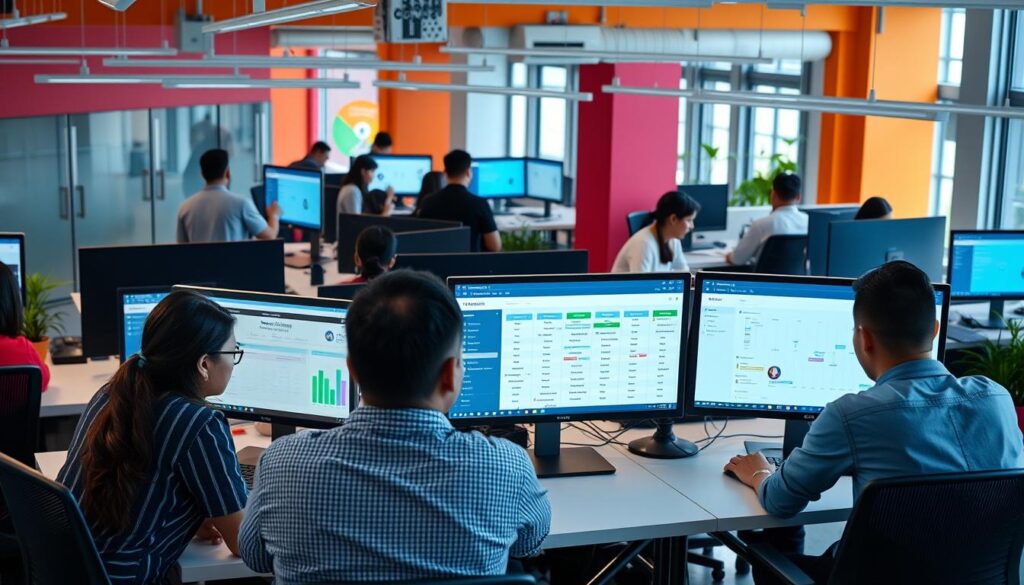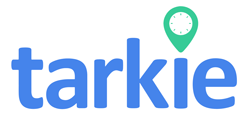Ever thought about how much time and money your company could save with automated time tracking? It’s a big deal for companies looking to work smarter. Automated tracking makes it easier to manage work hours and productivity in real-time. This helps businesses grow and keeps employees happy.
This new way of tracking work hours helps teams work better together. It’s all about making the most of every minute. Automated systems cut down on mistakes and make payroll easier. So, how can your company use this technology to its fullest? Let’s dive into the benefits of automated time tracking.
Key Takeaways
- Automated time tracking increases accuracy, reducing missed time entries that could impact revenue.
- Timely integration with over 100 apps enhances collaboration and productivity.
- Mobile accessibility supports remote work, adding to workforce flexibility.
- Biometric technology helps prevent time fraud, ensuring secure employee identification.
- Significant time savings allow HR teams to focus on strategic initiatives rather than manual entry.
- Streamlined reporting tools provide essential insights for better workforce planning.
The Importance of Automated Time Tracking
In today’s business world, automated time tracking is key for companies wanting to be precise and efficient. Old ways of tracking time often lead to mistakes, affecting how much employees get paid. A system that automates this makes payroll much more accurate, cutting down on errors.
Studies reveal that about 40% of small businesses struggle with time tracking. Automated tools help by making it easier to track time, freeing up teams from extra work. By using these systems, companies can cut payroll processing time by half, showing how well they work.
Getting attendance right is vital to avoid costly mistakes in payroll, with 74% of employers agreeing. Automation helps keep things accurate and makes teams more open. Employees who use mobile apps to track their hours are 30% more likely to do it right than those who don’t.
Businesses that use automated timekeeping see a 30% jump in employee happiness. This is because payments are reliable and work flows better. When tied to payroll systems, these tools can cut down on mistakes by about 60%, keeping finances in order.
![]()
How Automated Time Tracking Enhances Workforce Flexibility
Automated time tracking is key in today’s fast-changing business world. It helps manage schedules accurately, even when teams work remotely. This makes it easier for companies to keep up with their goals.
Companies can quickly adjust to changes in employee schedules and locations. This ensures everyone stays on track with the company’s objectives. For example, retailers use these systems to handle complex schedules and payroll for their teams. Healthcare places rely on them to manage diverse staff schedules well.
These systems help employees balance work and personal life. Schools use them for staff and student tracking. A user-friendly interface lets employees easily manage their hours and adjust schedules.
These systems also help reduce absenteeism and improve attendance. This is crucial in the Philippines, where businesses need to be quick to adapt. Investing in automated time tracking boosts efficiency, employee satisfaction, and productivity.
![]()
Benefits of Accurate Attendance in the Workplace
Accurate attendance is key for better performance and payroll management. A time and attendance system makes tracking work hours easy. This cuts down payroll time by 50-80%, depending on the company size and complexity.
Using efficient systems can cut payroll errors by up to 40%. This saves a lot on labor costs. Managers get real-time data to check productivity and performance, leading to better analysis.
Companies using these systems save 5-10% on labor costs. Automated systems also make employees 15-25% happier. This leads to a 20% boost in productivity, helping the business grow and keeping employees engaged.
Employers see a 30% better team communication with self-service features. This clears up schedule and time off issues. Biometric authentication cuts attendance errors by 40% compared to old methods.

Companies following labor laws closely, up to 90%, avoid legal issues. Real-time features help managers quickly address issues. They also help employees manage their time better, organizing their schedules.
| Benefits | Metrics |
|---|---|
| Decrease in Payroll Errors | Up to 40% |
| Labor Cost Savings | 5-10% |
| Increase in Employee Satisfaction Scores | 15-25% |
| Improvement in Communication Efficiency | 30% |
| Compliance Rate with Labor Laws | 90% |
| Reduction in Attendance-related Errors | 40% |
By using accurate attendance tracking, companies do well and keep their workforce happy and involved.
Features of Effective Employee Scheduling Software
Good employee scheduling software has key features that make it work well. It helps manage the workforce better. Companies that use real-time tracking and reporting work more efficiently. This makes their employees more productive and perform better.
Real-time tracking and reporting
Real-time tracking lets managers see what employees are doing right away. This helps spot problems and adjust schedules quickly. Businesses that use this feature see big improvements in how they work. They also see a 20% boost in productivity thanks to better analytics.
User-friendly interface
A simple interface is key. It makes it easy for everyone to use the scheduling software. When it’s easy to use, training takes less time. This means employees can start using it faster.
Companies that focus on making it easy for users are happier. This makes it a big part of a good workforce management solution.
Integration with other workforce management tools
Being able to connect with other tools is very important. Good employee scheduling software works well with payroll, HR, and time-tracking systems. This makes sure data flows smoothly and reports are accurate.
It can cut down payroll mistakes by 40%. This makes businesses run better and follow labor laws more easily.

| Feature | Benefits |
|---|---|
| Real-time Tracking | Increased operational efficiency, up to 20% productivity improvement |
| User-friendly Interface | Reduced training time, heightened employee satisfaction |
| Integration Capabilities | Streamlined operations, reduced payroll errors by 40% |
Understanding Time and Attendance Systems
Time and attendance systems are key for businesses to track employee hours and simplify payroll. They use automated tracking, reducing errors. Cloud-based systems make it easy for managers to check on different locations from anywhere.
Using a time and attendance system brings many benefits. It cuts down on errors by up to 80%. It also makes teams more accountable and transparent. Features like real-time tracking and employee portals help spot trends and reduce HR work.
- Convenience of mobile time tracking: Great for remote teams, allowing easy clocking in and out.
- Compliance tracking: Prevents labor law violations, protecting companies from fines or legal trouble.
- Improved security: Biometric systems reduce buddy punching, improving team integrity.
In the Philippines, small and medium enterprises (SMEs) gain a lot from time and attendance systems. Managers can better understand productivity and control costs. Regular audits help spot absenteeism patterns, guiding staffing decisions.
These systems help with labor laws and boost employee loyalty and morale. They ensure fair pay. By focusing on strategy, businesses can achieve better results.
Combining Automated Time Tracking with Workforce Management Solutions
Merging automated time tracking with a comprehensive workforce management solution is a game-changer for businesses. It boosts operational efficiency and helps keep accurate attendance records. This leads to better accountability among employees.
By integrating these systems, businesses can track employee performance and use resources wisely. This approach optimizes productivity.
Over 100 work applications are supported for automated time tracking, including Slack, Jira, Asana, and Zoom. This means businesses can pick the tools that fit their workflows best. Error-free time data entry ensures accurate timesheet submissions, reducing inaccuracies and keeping labor laws in check.
Automatic gross pay calculations ensure employees get paid right. Real-time updates based on changing data help businesses adjust quickly. Time-off policies, like vacation and sick leave, help employees balance work and life.
AI-powered SmartSchedule finds the best employee resources, improving scheduling. Mobile timesheets let employees manage their time anywhere. This mobile-first approach also includes advanced security, like Face ID® and Touch ID®, to protect personal info.
Geofencing technology makes data application for mobile workers more accurate. Touchless time clock solutions prevent time theft and buddy punching. These innovations help ensure accurate attendance.
The payroll workbench makes managing pay data easier, ensuring smooth validation and adjustments. In the competitive Philippines market, using these integrated solutions gives businesses a big edge. It leads to better employee engagement, operational integrity, and compliance with regulations.
How a Time Tracking App Can Benefit SMEs in the Philippines
Using a time tracking app can change how SMEs in the Philippines work. It makes everyone more accountable, leading to better productivity. When hours are tracked well, people pay more attention to how they spend their time. This helps them finish projects faster and work better overall.
Increased productivity through accountability
Research shows that 20% of productivity gains come from using time tracking apps. These apps help spot where time is wasted. This is key for SMEs in the Philippines, as 40% struggle with old ways of tracking time.
Switching to a time tracking app cuts down on mistakes, which are common with manual tracking. About 60% of errors come from manual methods. Employees feel better when they see how their time is used, leading to more job satisfaction. Almost 45% of workers are happier when time tracking helps with fair pay.
Case studies from Philippine companies
Local businesses that use automated time tracking see big improvements. For example, using biometric systems cuts down on time fraud by 30%. This makes sure who is working is accurate.
Also, 70% of small businesses follow labor laws better with detailed records. This means they can work without worrying about legal problems. Over 500 companies trust Flowace, showing its effectiveness. As more businesses use time tracking apps, they get better at managing their teams.
Challenges of Implementing Automated Time Tracking
Starting automated time tracking systems can be tough for companies. One big issue is getting employees on board. Many see these systems as too much or like they’re being watched too closely. This can make them feel less valued or not trusted.
The cost to start is also a big worry. Companies have to pay for the software, train staff, and keep the system running. These implementation costs might stop some businesses from using automated time tracking, even though it’s good for them.
To make the switch work, companies should talk to employees early. Teaching them how automated time tracking makes things run smoother can help. It’s key to explain how it helps everyone meet deadlines better and work more efficiently.
When dealing with the challenges of automated time tracking, it’s important to build trust. Listening to what employees say and fixing their worries can help them accept the new system. Look for ways to cut costs without sacrificing what the system offers to both the company and its people.
Working towards better automated time tracking is worth it. It can cut down on mistakes and boost productivity, making the workplace better. For more on this, check out integrating timekeeping software with payroll systems.
Conclusion
Automated time tracking is key for businesses in today’s fast-paced world, like in the Philippines. It makes work more efficient and boosts productivity. This tech helps track work hours well and makes employees more accountable.
It also finds ways to work better and follows labor laws closely. This reduces the risk of fines. With it, people can work from anywhere, improving their work-life balance. This is crucial as more companies move to remote work.
Using automated time tracking means having a fair and productive workplace. It’s good for both the employees and the company. For small businesses, this tech is a big step towards growing and staying strong in a changing world.
